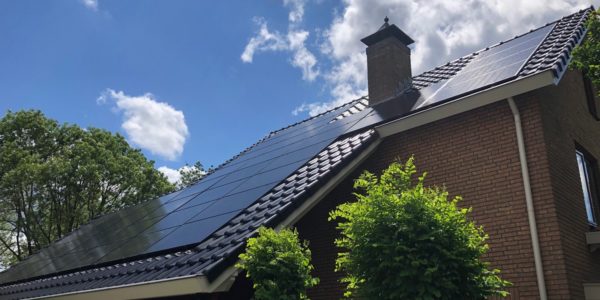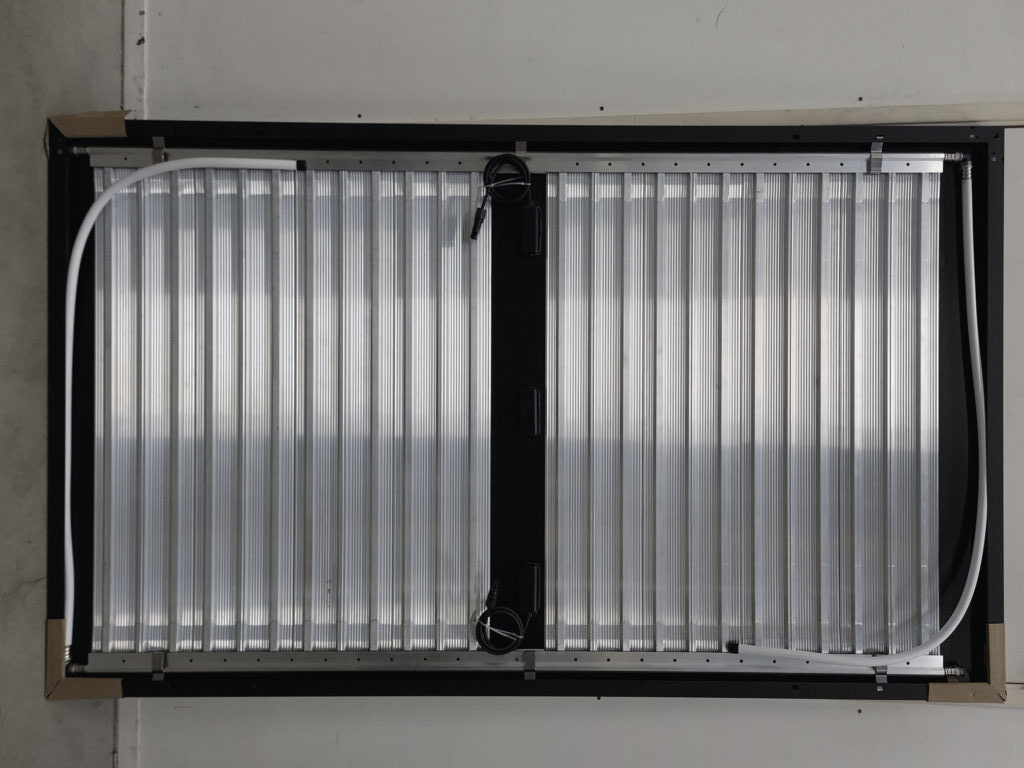From pv magazine Germany
René Siegerink is an automation engineer living in Bentelo in the Netherlands who has developed his own concept for the electric heating of the future. On the roof of his detached house built in 1978, Siegerink deployed a PV system and part of the modules were modified to ensure they not only produce electricity but also help to heat the house.
For two years now, the entrepreneur has no longer heated his home with gas, using instead a brine-water heat pump. That would not be a surprise, as such a system is a standard solution, with the brine being heated up with geothermal energy via a borehole and the heat pump powered with solar energy from the roof. Siegerink, however, did not use a hole in the ground. He developed an attachment that he strapped onto the back of the photovoltaic modules as a heat source for the brine-water cycle. He now produces and sells this solution with his company UseAllEnergy.
With this attachment, a heat exchanger, he transforms standard photovoltaic modules into photovoltaic solar thermal (PVT) modules. Such hybrid panels have been around for a long time. However, they couldn’t prevail on a larger scale. One reason for this is that the conversion of a standard PV module would put at risk the manufacturer's guarantee. Another reason is that the water temperatures are not close to the temperatures that pure solar thermal collectors can offer and heat yield is limited to very sunny days. Siegerink was able to solve both problems.
The pv magazine jury recognized the product as a top innovation highlight.

Image: Useallenergy
Known as the “Solar Heat Multipanel”, the solution solves one of the problems by not coupling the heat from the modified module directly into the house's heating system, but by using it as a source for the heat pump. A liquid circles between the heat exchanger on the roof and the heat pump, which cools it down and pumps it back onto the roof, where it heats up again in the surrounding air. Under this configuration, the thermal unit of the panel can work at lower temperatures than classic solar thermal modules, as it does not need direct sunlight. Furthermore, during the night the heat exchanger warms up from the ambient air and this effect is only possible by not insulating the back of its heat exchanger.
How much thermal energy can be generated is surprising. For example, if the heat pump cools the liquid medium to -10 degrees Celsius when the outside temperature is 0 degrees Celsius, a module can provide 300 W of thermal energy in the dark. But if the sun is shining in such a situation, the heat output increases to 650 W, explained Siegerink. At an outside temperature of 20 degrees, up to 873 W thermally are possible. Regardless of this, up to 380 W of electrical power comes on top when the sun is shining.
The thermal and electrical performance of the module at different temperatures and irradiation conditions is confirmed by the Solar Keymark quality label, which certifies the performance of solar thermal products and hybrid modules. UseAllEnergy claims it is close to being certified by Germany's TÜV Rheinland.
The thermal output of 12 modules is sufficient to supply a heat pump with an output of 6 kW. With a performance coefficient (COP) of 3.5, it requires 1.7 kW of electrical energy and 4.3 kW of environmental heat, which the modules must provide. Twelve modules also provide enough electrical energy to operate the heat pump in a CO2-neutral way throughout the year
Siegerink's heat pump has used an average of just under 3,300 kWh of electricity per year over the past two years. If a system owner wants to increase electricity self-sufficiency in winter, he can easily expand the module field with optically identical modules without a heat exchanger.
As for the issue with the guarantee, Siegerink convinced Chinese module manufacturer Longi that his heat exchanger does not damage the photovoltaic module, but rather increases the electrical performance through the cooling effect it provides. As a result, Longi has accepted UseAllEnergy‘s modifications to its HiMo4 plus module without the customer losing warranty claims.
The installation of the panels is claimed to be very easy. The aluminum heat exchanger with recesses for the connection box is attached to the backsheet with metal clips and can be removed at any time because no adhesive is used. It is only 19 millimeters thick so that it cannot be seen from the side and does not interfere with the usual fastening of the module. All parts of the module remain freely accessible for inspections and maintenance.
In principle, Siegerink's company could also manufacture these hybrid modules from other photovoltaic modules. The production of the heat exchangers is easy and can be converted to other formats at any time, he explained. So nothing stands in the way of series production. His company offers a 25-year product guarantee on the thermal effect and as protection against leaks in the absorber. Retrofitting existing photovoltaic systems would also be conceivable. However, the Solar Keymark label only applies to fully assembled products straight from the workshop.
The Solar Heat Multipanel in combination with brine-water heat pumps can best be compared with the use of air-water heat pumps. According to Siegerink, the performance is similar. Both can be easily retrofitted and require little space. In close proximity, however, the development of noise with air-water heat pumps can be problematic, which is not the case with the hybrid modules.
Siegerink expects the heat exchanger to cost €300 per module, plus installation. With both systems, the efficiency drops when the outside temperature drops and heat can no longer be extracted at -20 Celsius degrees at the latest. The possibility of cooling in summer is also limited at very high temperatures. For new buildings and if space is available, a system owner should consider a small additional underground storage, said Siegerink.
The heat pump can choose the warmer source depending on the outside temperature and the temperature in the buffer. On very sunny days, it can heat up the underground storage tank. On very cold days, the hybrid module may only be able to make a small contribution and most of the energy comes from the ground. If the moisture in the soil freezes in the process, the energy of the phase transition from water to ice can also be used. With an underground storage tank, the heat pump can also heat the modules under certain circumstances in order to prevent them from icing up.
This content is protected by copyright and may not be reused. If you want to cooperate with us and would like to reuse some of our content, please contact: editors@pv-magazine.com.



Good integration Concept of Solar Electricity, Solar Thermal and Refrigeration Cycle (enjoying typically a COP of 3-3.5 for Cooling and 4-4.5 for Heating… a COMBINED COP of 7-8) … 👍👍👏👏👏